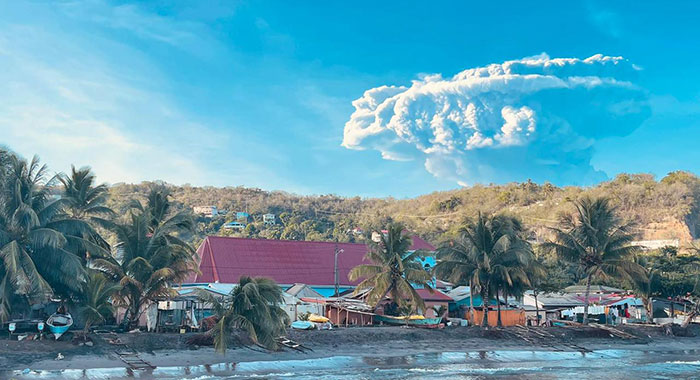By Kenton X. Chance
BARROUALLIE, St. Vincent (CMC) — The people of St. Vincent and the Grenadines needed no reminder Tuesday of the 42nd anniversary of the 1979 eruption of the La Soufriere volcano.It did so itself. At around 6:30 a.m. (local time/Atlantic Standard Time), the volcano erupted, the fifth day of the on-going activities sending another large plume of ash into the air.
And for yet another day, in this west coast town, located 12 miles north from the capital, Kingstown, eyes turned skyward in many areas of St. Vincent.
“The volcano is at alert level Red,” warned the Seismic Research Centre (SRC) of the University of the West Indies (UWI), noting that the volcano continues to erupt explosively and has now begun to generate pyroclastic density currents — hot (200 -700 degrees celcius), ground-hugging flows of ash and debris. “Explosions and accompanying ashfall, of similar or larger magnitude, are likely to continue to occur over the next few days impacting St. Vincent and neighbouring islands,” the SRC added.
People are still amazed by the strange beauty of the grey ash plumes against the blue sky, with some saying that “Our Lady La Soufriere” has uncorked her birthday champagne.
In St. Lucia, residents see the spray of the “champagne”, and in Soufriere, 24 miles south of Castries on the west coast, Arletta Johny, uses her mobile phone to capture the “celebration”.
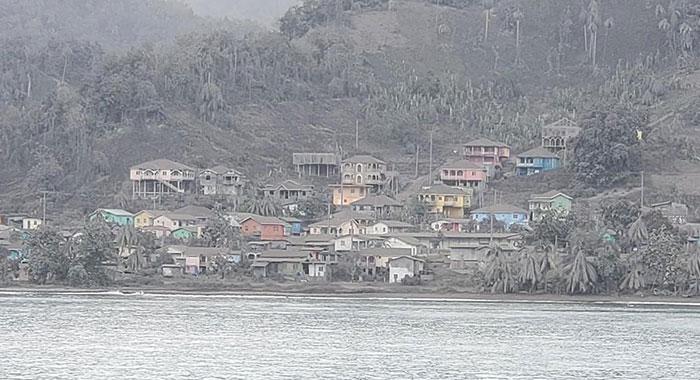
Volcanic ash has blanketed St. Vincent since Friday, choking off its water supply, and making driving in some areas akin to attempting to stand up in a water slide.
Volcanic ash has also been deposited in large areas of Barbados, but according to volcanologist, Professor Richard Robertson, the main scientist monitoring La Soufriere, the neighbouring Caribbean island should not expect too much ash from Tuesday’s eruption.
In St. Vincent, many residents had never experienced a volcanic eruption and some who had silently looked forward to it, are now explicitly saying they have had enough.
The devastation in the danger zone in northern St. Vincent is expected to be further compounded, one day after Robertson and his team, visited the area on board an SVG Coast Guard vessel and found scenes of utter destruction.
Innately destructive pyroclastic density currents (PDCs) had descended several valleys on the southern and western flanks of the volcano and had reached the sea at Morne Ronde, Larikai and Trois Loupes Bay — uninhabited areas in the mountain range on the northwest.
In some instances, the PDCs had travelled three miles, to reach the coast, where they are also a danger to persons at the coast or on the surrounding waters.
Robertson says no PDGs had been observed on the east coast, where there are several communities on the flanks of the volcano.
Monday’s PDCs were generated by a large explosion, at approximately 4:15 a.m. (local time), and more PDGs could be expected as the volcano enters the current phase of the eruption, in which dome building is expected to alternate with explosions.
In the five days since it erupted, the volcano has destroyed the dome left behind in 1979, as well as the new dome that began forming in December 2020.
In 1979, the eruption spewed 50 million cubic metres into the air, and so far, this year’s eruption has already displaced 70 million cubic metres, confirming anecdotal stories by residents that this is a worse eruption.
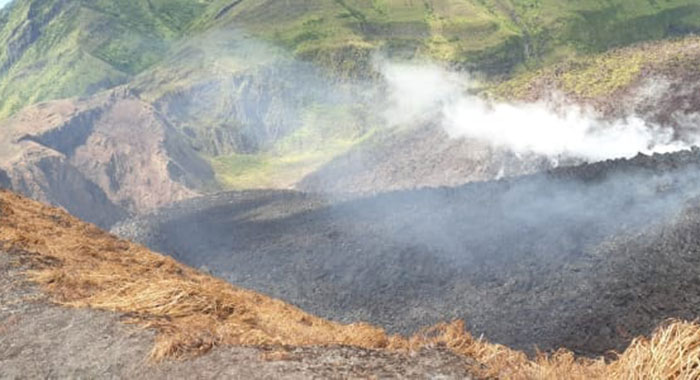
Explosions and accompanying ash fall, of similar or larger magnitude, are likely to continue to occur over the next few days, the monitoring team says.
As of Monday, 85 shelters with more than 3,782 occupants were activated and the SRC, which is monitoring the volcano, says that 16,000 people have evacuated.
“I have never seen nothing like this before. I heard of it, but never knew it would have been of this magnitude,” Sean Connell told the Caribbean Media Corporation on Sunday.
“I expected … it just [to] blow and then it’s over with,” said Connell, a resident of Walliabou, a community one mile north of here, on the boundary of the yellow and green zones. He is removing wet ash from a drain near his house, while some men used brooms to sweep the ash from the roof off the house.
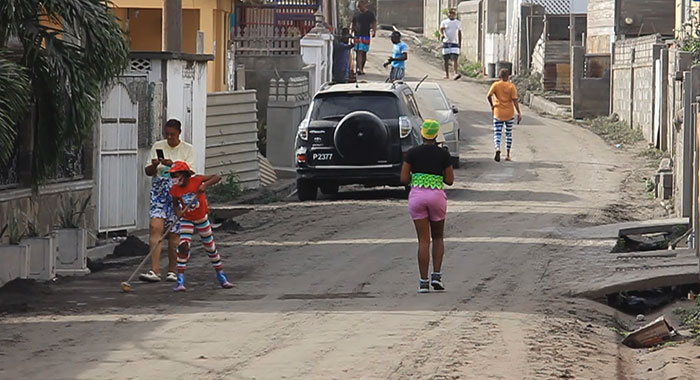
On the nearby roads leading to the danger zone, vehicles encounter grave difficulties traversing the steep hills where the ash has mixed with water to form a slippery slurry.
Elsewhere across the island, a number of vehicles skid off the island, ending up over embankment, but there are no reports of serious injuries as a result of these accidents or the eruption and evacuation.
Connell says ash is “one of the biggest problems we are facing really”.
Barrouallie is the first town, travelling south, in the safe zone in western St. Vincent. It was here that officials took evacuees Thursday night, after the order to move was given at 5 p.m.
With Robertson then convinced that an eruption would occur within 24 to 48 hours, inter-island boats ferried people from the west coast town of Chateaubelair — located 10 miles north of here.

From Barrouallie, evacuees were transported to emergency shelters or the private homes in which they would seek shelter.
At 8:40 a.m. Friday, the volcano erupts, sending persons who had not heeded the order to evacuate fleeing from their communities.
On Sunday, as the novelty of the eruption begins to wane and the impact takes root, in Bottle and Glass, a coastal village in this town, many Chateaubeliar residents trade stories about the eruption.
Among them is Akeeno Williams, 26, who had just returned from Chateaubelair. He had gone to attend to his livestock and to check on his sister’s shop.
“Down there is wilderness. Plants, everything, looks like they’re destroyed right now. Animals — it seems like you will have to sell them out because you would not get places to tie or feed them right now. Down there is harsh right now,” he tells CMC.
Williams is also concerned about people stealing his livestock and burglarising his sister’s shop.
“So I wanted to stay down there and make sure everything goes good,” Williams says, adding that his mother, who lives in Tortola, convinced him to evacuate.
“But it didn’t want to move,” Williams told CMC, even as he added that the ash was about three inches thick on the road and they had to use shovels to remove it from the road in some places where the truck was skidding.
“I feel real bad,” Williams says of seeing his community covered in ash. “It might take a couple years [to recover] — two, three years. Down there bad.”
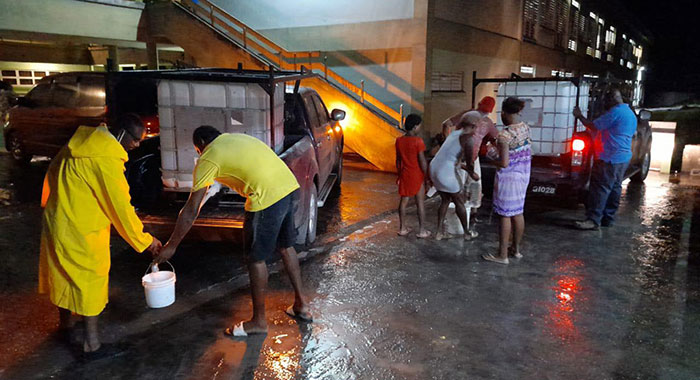
Meanwhile, Petro Anderson, a full-time Bottle and Glass resident, complains about the lack of potable water.
“We need some fresh water because all of the water that we filled up is finished. So that is my main concern,” says Anderson as she adjusted her facemask, now a shield against volcanic ash as well as the coronavirus (COVID-19).
“No water was brought to our area. Not yesterday; not today. We need some water. It’s the worst experience I ever see in my life. I prefer hurricanes right now, come and go. This is terrible,” says, Anderson, who was six years old in 1979 and could only remember dust blowing.
“I can [imagine] what my grandparents went through. And the elders say this is worse than in 1979,” Anderson adds.
“It is a lot of stress [toting] a lot of water and I am having a lot of headaches. But, it’s God’s work; we cannot do anything about that,” she says as she wished the best to all the people of St. Vincent and the Grenadines.
“My barrel’s empty right now and I have all my clothes to wash,” a younger man, who did not give his name, comments, as he complains about how soon the ash soils his clothes are soiled by the ash.
“We want water to cook, drink, and in this weather, if you don’t get water, it’s as if you are suffocating,” he says in the Vincentian vernacular.
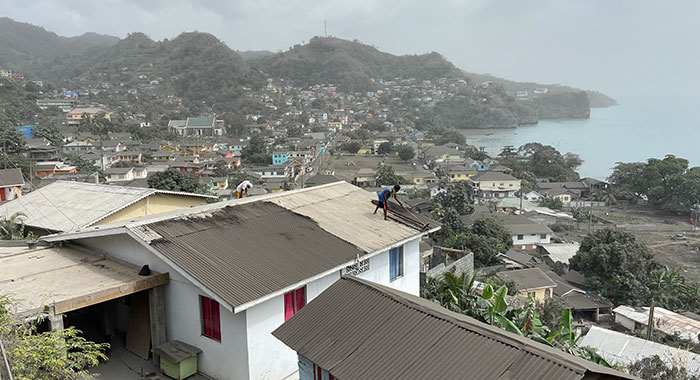
In another area of Barrouallie, Joelanzo Currency and his brother are helping people to clear ashes from their roofs.
“There is a lot of ash and if it gets wet, it can cause the roofs to collapse. So I am just helping out,” adding that he had cleaned his own roof, in another section of the town, as well as five other. I also cleaned the road. I took up some off the road up there,” he said.
While is not charging for his assistance, Currency is “collecting a little thing, because it’s like a strength (assistance). So you wouldn’t really push to collect money from people… You do something for them and collect a little change.”
Currency, 21, says he had not seen much of the impact of the volcano, but the ash was his biggest problem.
“I really can’t stand the dust and as far as I have heard, the thing isn’t done yet. It is kind of weird, surprising,” he says of the experience.
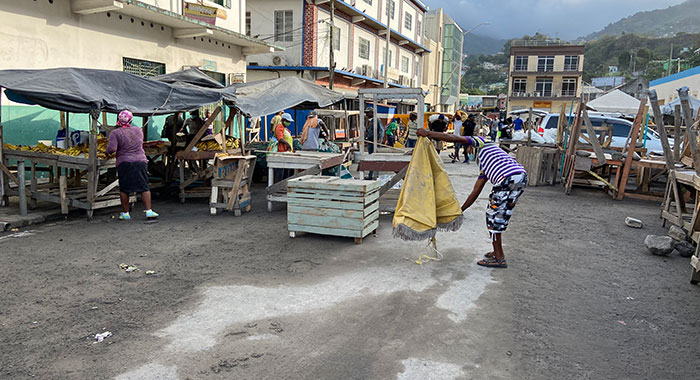
Daybreak in Kingstown, on Monday, men who wash cars see an increase in customers at their business along a riverside stream to the north of the city.
In the more centrally located Market Square, vendors are using brooms to sweep away ash from their stalls. Among them is a vendor who gives her name as Suzie
“When I came this morning, everything clammed down on top of the table because of the rain and the ash from the volcano, … it was like it was concrete. So we had to get brooms and knives and scrape it off and then we had to get water to wash it down.”
She says, however, the management of the Central Market, the complex in which vendors store their produce, is not as easy to negotiate as cleaning the ash.
The market remains closed as in the public sector only essential workers are expected to report to work and many private businesses remain closed.
“I don’t mind if the market stays closed, but give us our stuff so we can come out and sell,” Suzie told CMC, adding that much of the produce stored in the market could spoil if the market remains closed for an extended period.
“It is our livelihood. People are coming to buy. People in shelters need fresh greens and things like that. People are coming to cook food for the people in the shelter. Give us our goods; give us our produce.”
Also doing another type of cleaning are teams of workers from the Sanitation Department.
“We are out this morning and we are taking the ash out [of] the drain. The main intent is to ensure there is no blockage in case there is rain so that Kingstown doesn’t flood — although we hope that some rain can come and wash off the pavement and the street. Our main goal today, is to clear the drains,” Noel Douglas, a foreman at the Sanitation Department tells CMC.

With the novelty of a volcanic eruption, some persons seem to be finding it hard to resist the urge to sightsee.
The National Emergency Management Organisation (NEMO) is urging persons to desist from gathering at the Rabacca Bridge or anywhere else in the danger zones to view the pyroclastic flows coming from the erupting volcano.
“This is considered to be EXTREMELY DANGEROUS,” NEMO says in a Facebook post.
The bridge, which spans the Rabacca Dry River, has become a conduit for water heated to near boiling as a result of the eruption. Steam rises from the riverbed.
In another post, NEMO says that the police will immediately arrest anyone found in the Red Zone without permission and such persons and prosecuted to the full extent of the law.
“This will apply whether you are a usual resident of the area or not,” NEMO said.
In the safe zone in the south of the island, where some communities have been without water for up to 72 hours, there is good news from the Central Water and Sewage Authority (CWSA). Temporary standpipes have been erected in Biabou, San Souci, Mt. Grennan, Colonaire and Gorse
“The CWSA’s teams continue to work towards a restoration of supplies island wide, as soon as possible,” the municipal supplier of water states..
The pattern of seismic activity at La Soufriere changed again, on Monday, with the end of the episodes of high-amplitude tremor two to eight hours apart. Humanitarian aid has begun to arrive, including a shipment from Venezuela on-board the Bolivarian Navy Ship AB Goajira (T-63), which arrived in Kingstown on Monday.

The United Kingdom is providing emergency rapid crisis funds and urgently needed technical experts will support relief efforts on the ground, support emergency telecommunications, and restore critical lifeline facilities, like transport links
The UK has also provided an initial 200,000 pounds sterling, via the Foreign, Commonwealth and Development Office to support the regional response, through the Caribbean Disaster Emergency Management Agency (CDEMA).
Tsai Ing-wen, president of Taiwan, one of St. Vincent and the Grenadines’ closest allies, spoke with Prime Minister Ralph Gonsalves after Friday’s eruption.
“We are closely monitoring reports on the volcanic eruption & ongoing evacuation in St. Vincent & the Grenadines. Taiwan remains ready and willing to help our friends in #SVG as needed,” Tsai said on Twitter.
On Tuesday, Robertson said that the volcano could alternate between dome building and eruption. This could last for days, weeks or months, before an all clear is given.




